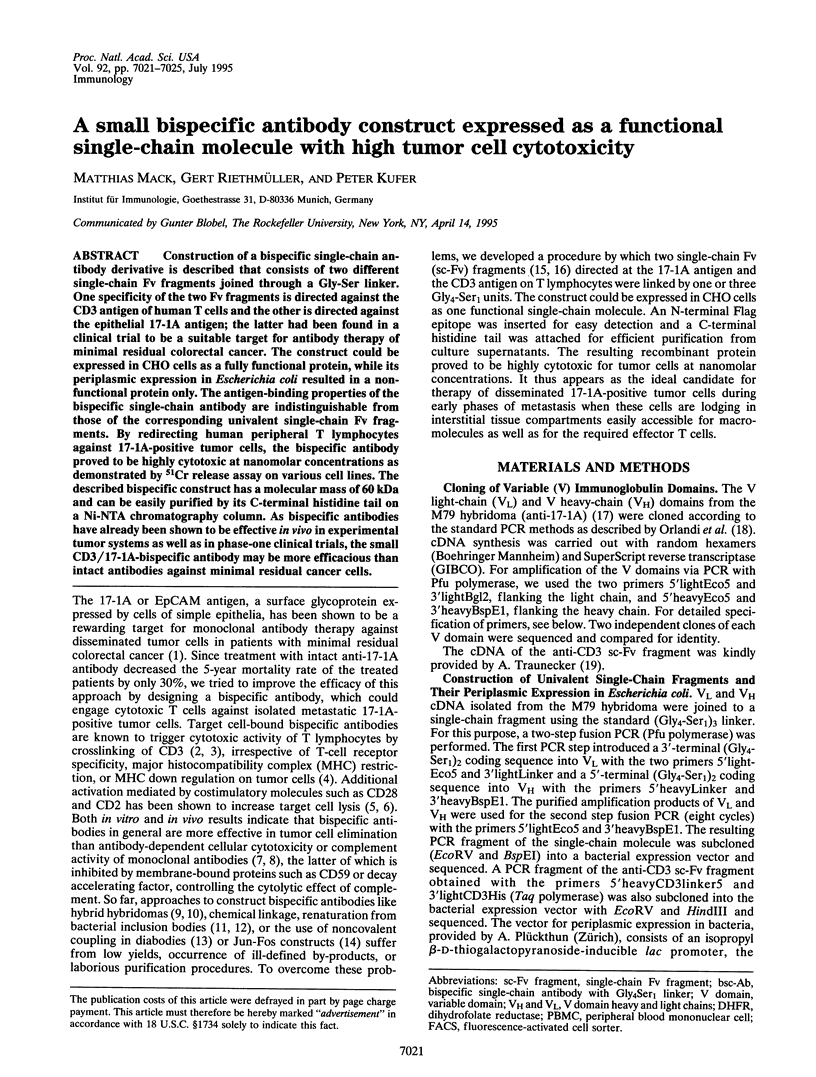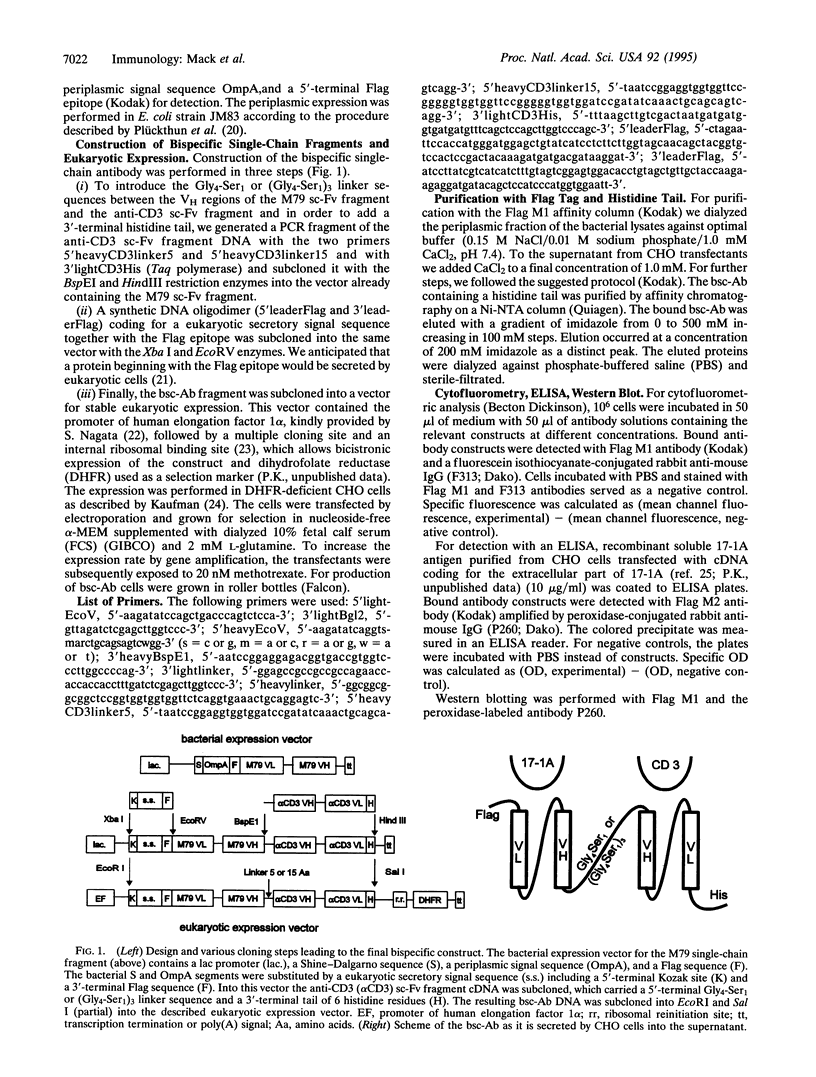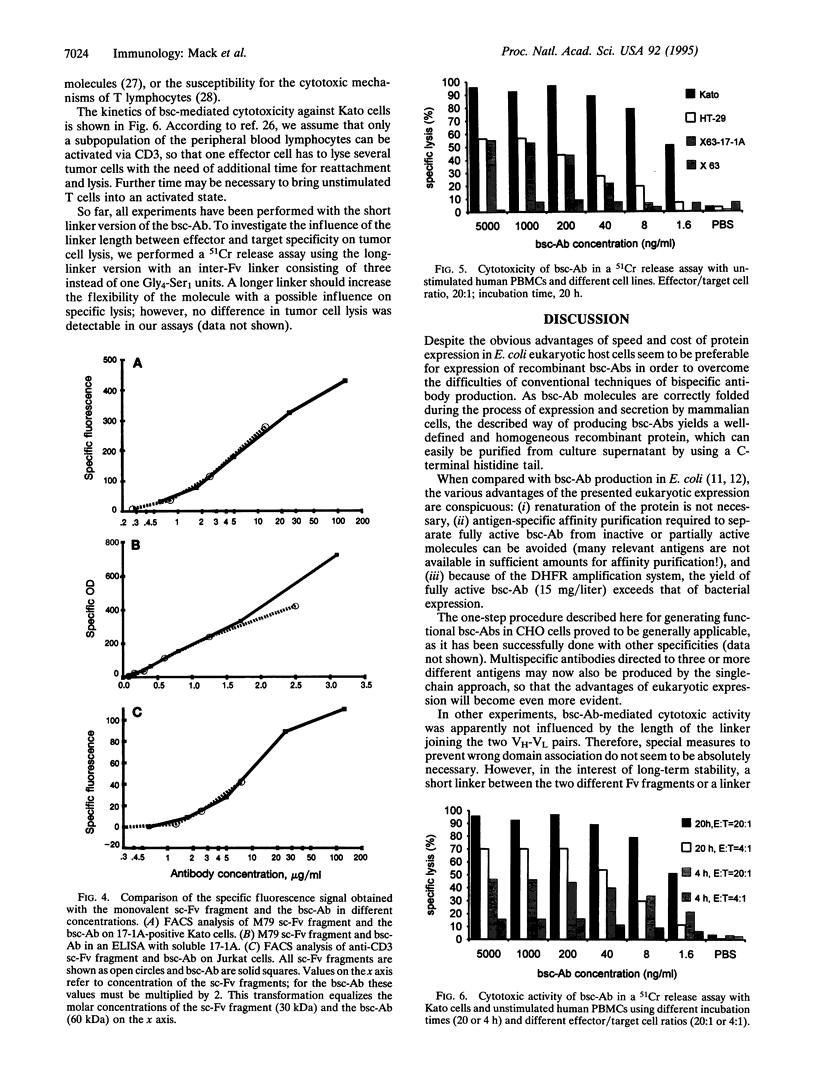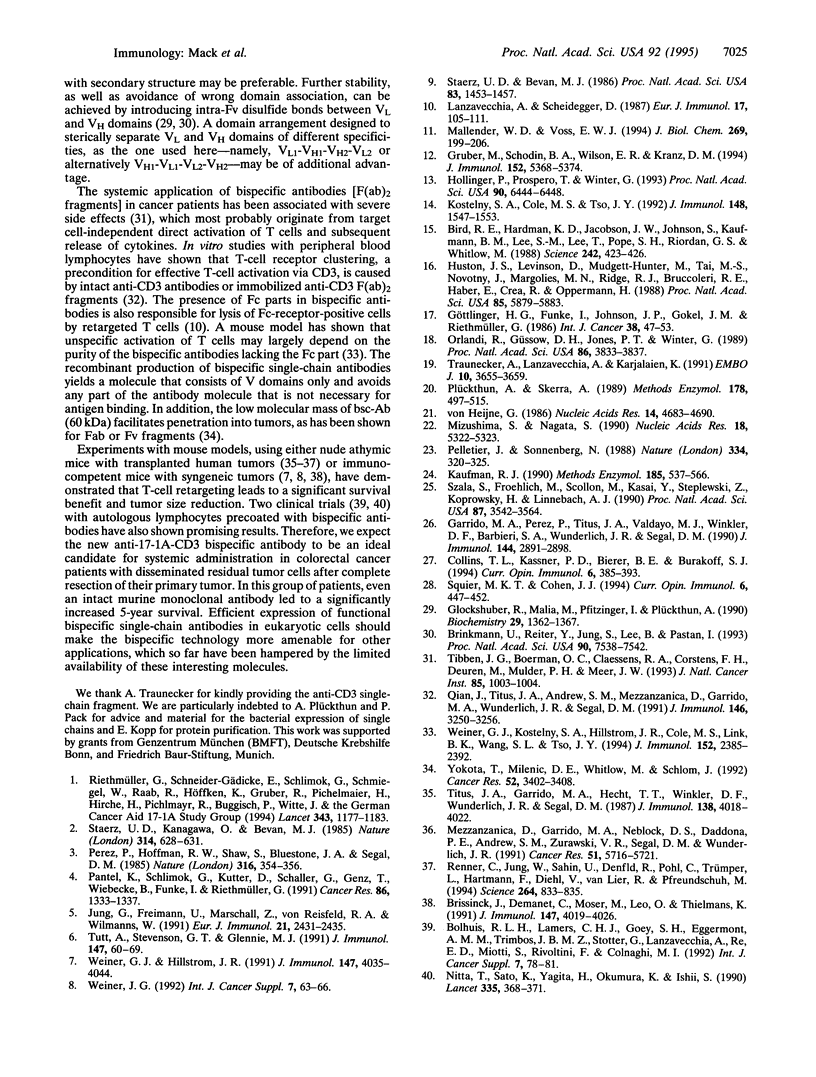Abstract
Construction of a bispecific single-chain antibody derivative is described that consists of two different single-chain Fv fragments joined through a Gly-Ser linker. One specificity of the two Fv fragments is directed against the CD3 antigen of human T cells and the other is directed against the epithelial 17-1A antigen; the latter had been found in a clinical trial to be a suitable target for antibody therapy of minimal residual colorectal cancer. The construct could be expressed in CHO cells as a fully functional protein, while its periplasmic expression in Escherichia coli resulted in a nonfunctional protein only. The antigen-binding properties of the bispecific single-chain antibody are indistinguishable from those of the corresponding univalent single-chain Fv fragments. By redirecting human peripheral T lymphocytes against 17-1A-positive tumor cells, the bispecific antibody proved to be highly cytotoxic at nanomolar concentrations as demonstrated by 51Cr release assay on various cell lines. The described bispecific construct has a molecular mass of 60 kDa and can be easily purified by its C-terminal histidine tail on a Ni-NTA chromatography column. As bispecific antibodies have already been shown to be effective in vivo in experimental tumor systems as well as in phase-one clinical trials, the small CD3/17-1A-bispecific antibody may be more efficacious than intact antibodies against minimal residual cancer cells.
Full text
PDF




Images in this article
Selected References
These references are in PubMed. This may not be the complete list of references from this article.
- Bird R. E., Hardman K. D., Jacobson J. W., Johnson S., Kaufman B. M., Lee S. M., Lee T., Pope S. H., Riordan G. S., Whitlow M. Single-chain antigen-binding proteins. Science. 1988 Oct 21;242(4877):423–426. doi: 10.1126/science.3140379. [DOI] [PubMed] [Google Scholar]
- Bolhuis R. L., Lamers C. H., Goey S. H., Eggermont A. M., Trimbos J. B., Stoter G., Lanzavecchia A., di Re E., Miotti S., Raspagliesi F. Adoptive immunotherapy of ovarian carcinoma with bs-MAb-targeted lymphocytes: a multicenter study. Int J Cancer Suppl. 1992;7:78–81. [PubMed] [Google Scholar]
- Brinkmann U., Reiter Y., Jung S. H., Lee B., Pastan I. A recombinant immunotoxin containing a disulfide-stabilized Fv fragment. Proc Natl Acad Sci U S A. 1993 Aug 15;90(16):7538–7542. doi: 10.1073/pnas.90.16.7538. [DOI] [PMC free article] [PubMed] [Google Scholar]
- Brissinck J., Demanet C., Moser M., Leo O., Thielemans K. Treatment of mice bearing BCL1 lymphoma with bispecific antibodies. J Immunol. 1991 Dec 1;147(11):4019–4026. [PubMed] [Google Scholar]
- Collins T. L., Kassner P. D., Bierer B. E., Burakoff S. J. Adhesion receptors in lymphocyte activation. Curr Opin Immunol. 1994 Jun;6(3):385–393. doi: 10.1016/0952-7915(94)90117-1. [DOI] [PubMed] [Google Scholar]
- Garrido M. A., Perez P., Titus J. A., Valdayo M. J., Winkler D. F., Barbieri S. A., Wunderlich J. R., Segal D. M. Targeted cytotoxic cells in human peripheral blood lymphocytes. J Immunol. 1990 Apr 15;144(8):2891–2898. [PubMed] [Google Scholar]
- Glockshuber R., Malia M., Pfitzinger I., Plückthun A. A comparison of strategies to stabilize immunoglobulin Fv-fragments. Biochemistry. 1990 Feb 13;29(6):1362–1367. doi: 10.1021/bi00458a002. [DOI] [PubMed] [Google Scholar]
- Gruber M., Schodin B. A., Wilson E. R., Kranz D. M. Efficient tumor cell lysis mediated by a bispecific single chain antibody expressed in Escherichia coli. J Immunol. 1994 Jun 1;152(11):5368–5374. [PubMed] [Google Scholar]
- Göttlinger H. G., Funke I., Johnson J. P., Gokel J. M., Riethmüller G. The epithelial cell surface antigen 17-1A, a target for antibody-mediated tumor therapy: its biochemical nature, tissue distribution and recognition by different monoclonal antibodies. Int J Cancer. 1986 Jul 15;38(1):47–53. doi: 10.1002/ijc.2910380109. [DOI] [PubMed] [Google Scholar]
- Holliger P., Prospero T., Winter G. "Diabodies": small bivalent and bispecific antibody fragments. Proc Natl Acad Sci U S A. 1993 Jul 15;90(14):6444–6448. doi: 10.1073/pnas.90.14.6444. [DOI] [PMC free article] [PubMed] [Google Scholar]
- Huston J. S., Levinson D., Mudgett-Hunter M., Tai M. S., Novotný J., Margolies M. N., Ridge R. J., Bruccoleri R. E., Haber E., Crea R. Protein engineering of antibody binding sites: recovery of specific activity in an anti-digoxin single-chain Fv analogue produced in Escherichia coli. Proc Natl Acad Sci U S A. 1988 Aug;85(16):5879–5883. doi: 10.1073/pnas.85.16.5879. [DOI] [PMC free article] [PubMed] [Google Scholar]
- Jung G., Freimann U., Von Marschall Z., Reisfeld R. A., Wilmanns W. Target cell-induced T cell activation with bi- and trispecific antibody fragments. Eur J Immunol. 1991 Oct;21(10):2431–2435. doi: 10.1002/eji.1830211020. [DOI] [PubMed] [Google Scholar]
- Kaufman R. J. Selection and coamplification of heterologous genes in mammalian cells. Methods Enzymol. 1990;185:537–566. doi: 10.1016/0076-6879(90)85044-o. [DOI] [PubMed] [Google Scholar]
- Kostelny S. A., Cole M. S., Tso J. Y. Formation of a bispecific antibody by the use of leucine zippers. J Immunol. 1992 Mar 1;148(5):1547–1553. [PubMed] [Google Scholar]
- Lanzavecchia A., Scheidegger D. The use of hybrid hybridomas to target human cytotoxic T lymphocytes. Eur J Immunol. 1987 Jan;17(1):105–111. doi: 10.1002/eji.1830170118. [DOI] [PubMed] [Google Scholar]
- Mallender W. D., Voss E. W., Jr Construction, expression, and activity of a bivalent bispecific single-chain antibody. J Biol Chem. 1994 Jan 7;269(1):199–206. [PubMed] [Google Scholar]
- Mezzanzanica D., Garrido M. A., Neblock D. S., Daddona P. E., Andrew S. M., Zurawski V. R., Jr, Segal D. M., Wunderlich J. R. Human T-lymphocytes targeted against an established human ovarian carcinoma with a bispecific F(ab')2 antibody prolong host survival in a murine xenograft model. Cancer Res. 1991 Oct 15;51(20):5716–5721. [PubMed] [Google Scholar]
- Mizushima S., Nagata S. pEF-BOS, a powerful mammalian expression vector. Nucleic Acids Res. 1990 Sep 11;18(17):5322–5322. doi: 10.1093/nar/18.17.5322. [DOI] [PMC free article] [PubMed] [Google Scholar]
- Nitta T., Sato K., Yagita H., Okumura K., Ishii S. Preliminary trial of specific targeting therapy against malignant glioma. Lancet. 1990 Feb 17;335(8686):368–371. doi: 10.1016/0140-6736(90)90205-j. [DOI] [PubMed] [Google Scholar]
- Orlandi R., Güssow D. H., Jones P. T., Winter G. Cloning immunoglobulin variable domains for expression by the polymerase chain reaction. Proc Natl Acad Sci U S A. 1989 May;86(10):3833–3837. doi: 10.1073/pnas.86.10.3833. [DOI] [PMC free article] [PubMed] [Google Scholar]
- Pelletier J., Sonenberg N. Internal initiation of translation of eukaryotic mRNA directed by a sequence derived from poliovirus RNA. Nature. 1988 Jul 28;334(6180):320–325. doi: 10.1038/334320a0. [DOI] [PubMed] [Google Scholar]
- Perez P., Hoffman R. W., Shaw S., Bluestone J. A., Segal D. M. Specific targeting of cytotoxic T cells by anti-T3 linked to anti-target cell antibody. Nature. 1985 Jul 25;316(6026):354–356. doi: 10.1038/316354a0. [DOI] [PubMed] [Google Scholar]
- Plückthun A., Skerra A. Expression of functional antibody Fv and Fab fragments in Escherichia coli. Methods Enzymol. 1989;178:497–515. doi: 10.1016/0076-6879(89)78036-8. [DOI] [PubMed] [Google Scholar]
- Qian J. H., Titus J. A., Andrew S. M., Mezzanzanica D., Garrido M. A., Wunderlich J. R., Segal D. M. Human peripheral blood lymphocytes targeted with bispecific antibodies release cytokines that are essential for inhibiting tumor growth. J Immunol. 1991 May 1;146(9):3250–3256. [PubMed] [Google Scholar]
- Renner C., Jung W., Sahin U., Denfeld R., Pohl C., Trümper L., Hartmann F., Diehl V., van Lier R., Pfreundschuh M. Cure of xenografted human tumors by bispecific monoclonal antibodies and human T cells. Science. 1994 May 6;264(5160):833–835. doi: 10.1126/science.8171337. [DOI] [PubMed] [Google Scholar]
- Riethmüller G., Schneider-Gädicke E., Schlimok G., Schmiegel W., Raab R., Höffken K., Gruber R., Pichlmaier H., Hirche H., Pichlmayr R. Randomised trial of monoclonal antibody for adjuvant therapy of resected Dukes' C colorectal carcinoma. German Cancer Aid 17-1A Study Group. Lancet. 1994 May 14;343(8907):1177–1183. doi: 10.1016/s0140-6736(94)92398-1. [DOI] [PubMed] [Google Scholar]
- Squier M. K., Cohen J. J. Cell-mediated cytotoxic mechanisms. Curr Opin Immunol. 1994 Jun;6(3):447–452. doi: 10.1016/0952-7915(94)90126-0. [DOI] [PubMed] [Google Scholar]
- Staerz U. D., Bevan M. J. Hybrid hybridoma producing a bispecific monoclonal antibody that can focus effector T-cell activity. Proc Natl Acad Sci U S A. 1986 Mar;83(5):1453–1457. doi: 10.1073/pnas.83.5.1453. [DOI] [PMC free article] [PubMed] [Google Scholar]
- Staerz U. D., Kanagawa O., Bevan M. J. Hybrid antibodies can target sites for attack by T cells. Nature. 1985 Apr 18;314(6012):628–631. doi: 10.1038/314628a0. [DOI] [PubMed] [Google Scholar]
- Szala S., Froehlich M., Scollon M., Kasai Y., Steplewski Z., Koprowski H., Linnenbach A. J. Molecular cloning of cDNA for the carcinoma-associated antigen GA733-2. Proc Natl Acad Sci U S A. 1990 May;87(9):3542–3546. doi: 10.1073/pnas.87.9.3542. [DOI] [PMC free article] [PubMed] [Google Scholar]
- Tibben J. G., Boerman O. C., Claessens R. A., Corstens F. H., van Deuren M., de Mulder P. H., van der Meer J. W., Keijser K. G., Massuger L. F. Cytokine release in an ovarian carcinoma patient following intravenous administration of bispecific antibody OC/TR F(ab')2. J Natl Cancer Inst. 1993 Jun 16;85(12):1003–1004. doi: 10.1093/jnci/85.12.1003. [DOI] [PubMed] [Google Scholar]
- Titus J. A., Garrido M. A., Hecht T. T., Winkler D. F., Wunderlich J. R., Segal D. M. Human T cells targeted with anti-T3 cross-linked to antitumor antibody prevent tumor growth in nude mice. J Immunol. 1987 Jun 1;138(11):4018–4022. [PubMed] [Google Scholar]
- Traunecker A., Lanzavecchia A., Karjalainen K. Bispecific single chain molecules (Janusins) target cytotoxic lymphocytes on HIV infected cells. EMBO J. 1991 Dec;10(12):3655–3659. doi: 10.1002/j.1460-2075.1991.tb04932.x. [DOI] [PMC free article] [PubMed] [Google Scholar]
- Tutt A., Stevenson G. T., Glennie M. J. Trispecific F(ab')3 derivatives that use cooperative signaling via the TCR/CD3 complex and CD2 to activate and redirect resting cytotoxic T cells. J Immunol. 1991 Jul 1;147(1):60–69. [PubMed] [Google Scholar]
- Weiner G. J. Bispecific IgG and IL-2 therapy of a syngeneic B-cell lymphoma in immunocompetent mice. Int J Cancer Suppl. 1992;7:63–66. [PubMed] [Google Scholar]
- Weiner G. J., Hillstrom J. R. Bispecific anti-idiotype/anti-CD3 antibody therapy of murine B cell lymphoma. J Immunol. 1991 Dec 1;147(11):4035–4044. [PubMed] [Google Scholar]
- Weiner G. J., Kostelny S. A., Hillstrom J. R., Cole M. S., Link B. K., Wang S. L., Tso J. Y. The role of T cell activation in anti-CD3 x antitumor bispecific antibody therapy. J Immunol. 1994 Mar 1;152(5):2385–2392. [PubMed] [Google Scholar]
- Yokota T., Milenic D. E., Whitlow M., Schlom J. Rapid tumor penetration of a single-chain Fv and comparison with other immunoglobulin forms. Cancer Res. 1992 Jun 15;52(12):3402–3408. [PubMed] [Google Scholar]
- von Heijne G. A new method for predicting signal sequence cleavage sites. Nucleic Acids Res. 1986 Jun 11;14(11):4683–4690. doi: 10.1093/nar/14.11.4683. [DOI] [PMC free article] [PubMed] [Google Scholar]



